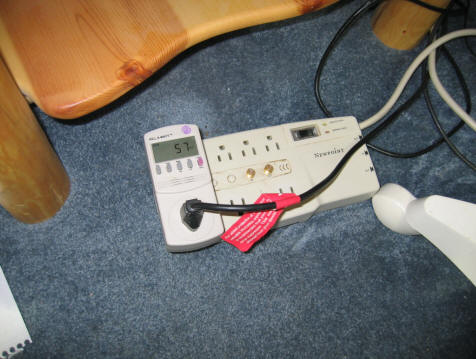
Search
The Renewable Energy site for Do-It-Yourselfers
1/2 -- Using the Kill-A-Watt
|
The Kill A Watt allows you to measure
the power being used by any device that plugs into a regular wall socket.
To use it, you just plug the Kill A
Watt into a wall socket, and then plug your device into the socket on the front
of the Kill A Watt. The Kill A Watt displays the power being used in
watts, and also adds up power use over time to give you the kilowatt hours
of energy used since the device was plugged into the Kill A Watt.
This is about the only way you can
really get a handle on how much power your plug in gadgets consume, and
determine how much power they use when the are turned "off". Some
devices consume quite a bit of power even when turned off. The Kill A Watt
will let you find these -- you can then either unplug them when not in use, or
put them on a power strip that allows you turn everything on the strip off.
The Kill A Watt costs about $35.
There are other brands -- a little
information on the popular Watts Up competitor is listed below. |
|

Kill A Watt plugged into a power
strip (because the wall socket was hard to get at). It is reading the
power used by my Dish HDTV receiver/recorder with the receiver turned "off".
57 watts 24/7 works out to 500 KWH and 1000 lbs of green house gas per year!
Using the Kill-A-Watt
To find out how much power an appliance is using:
Plug the KillAWatt into the wall, and
then plug the appliance into the socket on the front of the KillAWatt.
Press the "Watt" to read the power
usage in watts
For some appliances the reading
may vary depending on what the appliance doing. For example, a printer
will use more power when printing than when idle.
Try turning the appliance off, and see if the power usage goes to zero.
Many appliances continue to use power even when turned "off" -- this can add
up over time, since power is being used 24/7. Appliances that use
power when turned off can be plugged into a power strip, and the switch on
the power strip switch used to turn the appliance off completely.
An appliance that uses 20 watts even when turned of will use 176
kilowatt-hours of energy in a year -- costing you about $18, and adding
about 350 lbs of greenhouse gas to the atmosphere.
To find out how much energy and
appliances uses over time:
Leave the appliance plugged into the
KillAWatt for a day or so to get a good average reading. The KillAWatt
will continuously monitor and add up the power used starting from the time you
plug in the KillAWatt.
To determine energy usage, press
the "kwh" key -- this will give you the number of kilowatt-hours that the
appliance has used since it was connected to the KillAWatt.
Press the "kwh" key a 2nd time, and
the KillAWatt will give you the number of hours over which this energy was
used.
A simple example:
Suppose you plug a lamp with a 100
watt bulb in it into the KillAWatt, and you leave it on for 27 hours.
When you take the KillAWatt readings
after 27 hours, you will get:
Pressing "Watts" gives
a reading of 100 watts (this is the current power usage of the lamp)
Pressing "KWH" gives a reading of 2.7
kilowatt-hours -- this is the total energy used by the lamp in the 27 hour
period.
Pressing "KWH" a 2nd time gives a reading of 27 hours -- this is the time
period over which the KillAWatt has recorded the 2.7 KWH of energy use.
How much is the lamp costing per
day if it is left on all day? per year?
Assume that you pay 10 cents per
KWH (you can get your actual charges from your electricity bill).
Energy use per hour = (2.7
KWH)/(27 hours) = 0.1 KWH per hour of use
Energy use per day = (0.1
KWH/hour)(24 hours/day) = 2.4 KWH over a full day
Cost per day = (2.4 KWH)(10
cents/KWH) = 24 cents per day
Energy use per year = (2.4
KWH/day)(365 days/year) = 876 KWH/year
Cost per year = (876 KWH/year)(10
cents/KWH) = $87.60 per year.
Just as a rough guide,
100 watts on for an hour is 0.1
KWH, and costs about a penny
100 watts on for a day is 2.4 KWH,
and costs about 24 cents
100 watts on for a year is 876 KWH,
and costs about $88
Generating the 876 KWH at a coal
fired power plant would result in the emission of 1750 lbs of Carbon Dioxide
into the atmosphere (as well as a number of other pollutants).
Watts Up? -- Another popular brand:
The Watts Up offers more features,
including logging data and PC analysis, but at a higher price.
https://www.doubleed.com/secure.html
Gary Updated Nov 5, 2007
